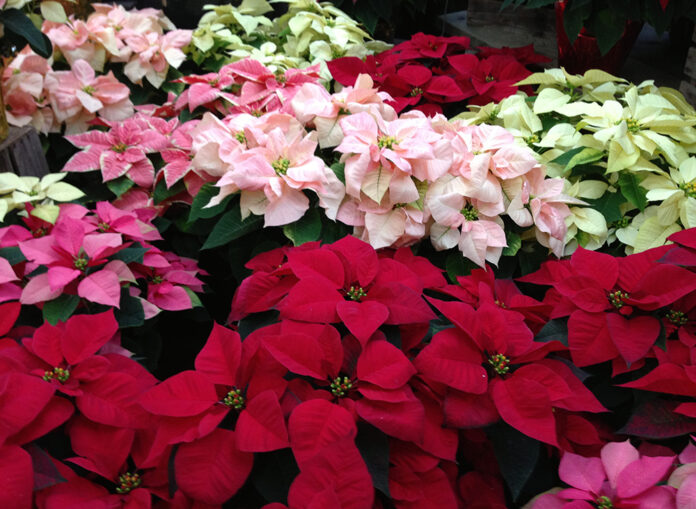
With the holiday season upon us, I like colorful plants on my tabletop and window sill. But how safe are holiday plants for pets like my cat Archer and dog Sherman or for small children?
I have a beautiful poinsettia on the table and, soon, I’ll be getting other holiday plants such as cyclamen, paperwhite narcissus, maybe a pink jasmine wreath or one with holly, ivy and evergreens. I also like those rosemary topiaries that are trained in the shape of a Christmas tree and have already started one of those huge showy amaryllis bulbs. Christmas cactus grow in several locations.
The classic plant to decorate our homes at this time of year is the poinsettia. Is poinsettia poisonous? Ohio State University conducted extensive research and concluded that although poinsettia sap from leaves and flowers might give you a stomach ache if you ate them, they won’t seriously hurt you. The sap may cause a rash if it comes in contact with the skin on some people. With this in mind, you should keep poinsettia plants out of the reach of curious pets and small children.
Poinsettia holds up well either as a cut flower or a living plant. Mostly it’s too cold here in the mountains for poinsettia to survive outside at night being native to Mexico, but they thrive in the warmth of the house. They need a bright spot and the soil should be allowed to dry slightly, but not completely, between waterings. Deprive them of either of these requirements and the lower leaves will yellow and drop. Also, be sure they aren’t sitting in water at the bottom of the container. Poinsettia are brittle and if you break off a branch, sear the end of the stem with a flame and it will hold up quite well in a vase or arrangement.
The other pet in my household, Sherman, a Welch springer spaniel, doesn’t usually pay attention to the plants but if they have plastic wrapping he’s been known to get into mischief. I usually put a couple of red and white cyclamen on a table in the house. Are cyclamen safe around the dog or cat?
According to the Pet Poison Helpline, cyclamen are mild to moderately toxic to dogs and cats if ingested, but it’s the root or corm that is especially toxic if ingested in large quantities. Pets and people react differently and it is unlikely that children would eat the corm and be affected.
My beautiful amaryllis flower and leaves are safe but the bulb is toxic. Amaryllis bulbs contain the same alkaloid that is found in narcissus and daffodil and is the reason deer know to leave them alone. Keep them away from pets and small children although ingesting a small amount will produce few or no symptoms.
Azalea leaves and Christmas cactus are toxic and should be kept away from pets and small children. Holly berries are also toxic if eaten in large quantities. Same for ivy.
Mistletoe contains multiple substances that are toxic to both dogs and cats. It can cause severe intestinal issues as well as a sudden and severe drop in blood pressure, breathing problems and even sometimes hallucinations. If a large amount of mistletoe or ivy is ingested, seizures and death may follow. The leaves and berries of holly and mistletoe plants, even dried, should be kept well out of your pet’s reach.
While serious complications aren’t likely with most holiday plants it’s still best to keep them away from small children and out of your pet’s reach.
Jan Nelson, a landscape designer and California certified nursery professional, will answer questions about gardening in the Santa Cruz Mountains. Email her at ja******@*ol.com, or visit jannelsonlandscapedesign.com.












